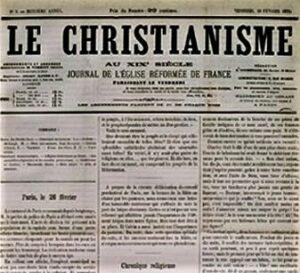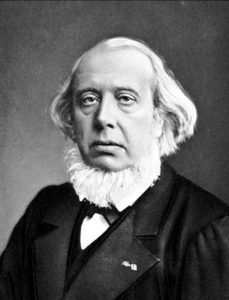Elitist journals and reviews
At first, the readership of this “press” consisted of only two social categories : the pastors and certain important noblemen who were considered eligible to vote because of their tax assessment. Together, they ran the institutions of the reformed Church and the Lutheran Church that had opted for the concordat until 1852.
To begin with, there were monthly or two monthly reviews in the “-8°”format. The first to appear was Archives du Christianisme (1818-1868), which was founded in Paris by pastor Juillerat-Chasseur. Its approach was fairly open on the theological level and it was also international ; members of its up-to-date editorial staff included both supporters of the Revival Movement and also liberals such Charles Coquerel.
Charles Coquerel created Annales protestantes in 1819, but this met with little success, so he went on to work for the Archives, becoming main editor in 1821, a post which he held for two years. Later, he was replaced by Frédéric Monod, who was a strong supporter of the Revival movement. However, progressively Paris ceased to be the centre of the protestant press, since Mélanges de Religion, de Morale et de Critique sacrée (10 volumes), was produced inNîmes, from 1820 to 1824, (later replaced by Revue protestante (Paris, Charles Coquerel, 1825-1828, 1830) and Religion et Christianisme (Nîmes, Samuel Vincent et Ferdinand Fontanès, January 1830 – August 1831, 4 volumes). In Strasbourg, the Lutheran professor Krafft edited Christliche Mitteilungen. (1821-1826). There was also another review read by the protestant bourgeoisie in Strasburg, the Courrier du Bas-Rhin (1815-1870), but this was not of a religious nature.
Such reviews did not deal very much with news : this was because of their format, the fact that they came out fairly infrequently and their elitist readership. Rather, there were in-depth articles of a meditative nature which often took up a great many pages, discussions and bibliographical notes. These all played an important part in the “continuous training” of pastors, especially with regard to Swiss and German theology.
In the Restauration period there was already a tendency for the protestant press to be divided between the journalists of Paris and Nîmes ; there was also a division between the supporters of the Revival movement and the liberals. In the time of the Monarchie de Juillet this development became even more marked. The Revival movement, apart from the review it was already publishing, Archives du Christianisme, began to produce a new review called Le Semeur (1831-1850). This was aimed at executives and was fairly intellectual ; it was run by Henri Lutteroth over a long period. Its liberal counterpart was Disciple de Jesus Christ, whose main editor was Joseph Martin-Paschoud from 1839 to 1873. The liberal journalists worked closely together and their reviews would be issued sometimes from Paris, sometimes from Nîmes, two regions which were important for Protestantism. Here are some examples : Le Protestant (Paris, Charles Coquerel, August 1831 – December 1833), Le libre examen (Paris, Athanase Coquerel, January 1834 – December 1836), L’Evangéliste (Valence-Nîmes, Ferdinand Fontanès, January 1837 – December 1840). However, the really new development was the fact that these reviews were coming out more frequently (every week or every two weeks), their format was “in folio” 4-8 pages with a double column of script used for editorials, and truly up to date information on religious topics. In this respect, the French Reformed press owed much to its Swiss models for this new format, (Le Protestant de Genève and La Gazette évangélique, journal de la Suisse française) and also the French Lutherans, for example the Protestanisches Kirchen und Schulblatt (1834 – 1848), which gave much information about the activities of the Directoire de Strasbourg.
It might appear that from then onwards, protestant reviews drew to a halt, but in fact, apart from the Semeur and the Disciple de Jesus Christ, some specialised reviews came into being, such as the Revue de théologie et de philosophie chrétienne (or Revue de Strasbourg, 1850-1857), set up by Edmond Scherer and Timothée Colani, or the Revue chrétienne (1854-1926), which was run by Edmond de Pressensé up until his death (1824-1891). This was similar to the Revue des Deux Mondes, becoming little by little the counterpart of the strongly catholic Correspondant over the years. This tendency to specialise can also be seen in the new Revue théologique, which first came out in 1874 in Montauban. It originally started off as the Supplement théologique, issued with the Revue chrétienne from 1863 onwards. Later, in 1891, the review was called Revue de théologie et des questions religieuses and was really the mouthpiece of the Faculty. Another specialised publication which started in 1852 was the Bulletin, issued by the Société de l’Histoire du Protestantisme Français.
Main publications of the protestant press
In the middle of the Monarchie de Juillet, a truly national press replaced the Parisian reviews and their provincial counterparts. The revival movement gave birth to a journal which embodied its ideas : L’Espérance, in 1838. This later changed its approach and it became the mouthpiece of a new national movement of the reformed evangelical Church which was no longer a separatist group, from 1842 to 1870. As it was both up to date and fairly marginal, the liberals did not deem it necessary to bring out their own newspaper until 1841, when Le Lien appeared. From this time onwards a truly protestant press appeared on the market, which changed its format progressively, finally emerging as a tabloid newspaper in four pages, with the text written in four or five columns, articles at the bottom of the page which included serials, anecdotes or meditative articles, headings, foreign news on page 3, summaries of books and also obituaries, short reports on religious gatherings and of course advertisements, probably necessary for financial reasons but which did not add any intellectual qualities to the newspaper.
This format was very similar to the political newspapers of the time and in 1846, the new La Voix Nouvelle (founded by pastor Philippe Boucher, who was once a Methodist) did indeed aim at being a political, rather than a religious newspaper, (or at the least, its object was to give a protestant viewpoint on the political events of the time). Sadly, however, this forerunner of Réforme had such a small readership that it disappeared in 1847 – this was because it had a vision of the protestant community which was ahead of its time and attracted few followers. On the other hand, Le Signal (1879-1894), founded and directed by the newly converted Eugène Réveillaud, managed to combine both general news and interesting religious articles. Two elements contributed to its success, first the powerful republican movement and later the first grumblings of anti-Protestantism.
So the three main protestant reviews, Archives du Christianisme, Espérance and Lien, continued until 1868-1871. They were later transformed into, respectively, L’Eglise libre (1869-1928) Le christianisme au XIXe siècle and La Renaissance (1871-1885) (which later became Le Protestant (1885-1901), thus making redundant the Journal du protestantisme français, which had being coming out on a very irregular basis. Even though they were the main protestant publications, several others also existed alongside them. They were Lutheran : (Le temoignage, 1865), Methodist : (Archives du méthodisme, 1858-1939), Baptist : L’Echo de la vérité), Free Evangelical : (L’Eclaireur, 1890) and even liberal reformed in the time of the Second Empire : (Le protestant libéral ; 1864-1870). All these publications gave their different points of view, sometimes just to assert their identity, sometimes with a view of upholding a particular policy within the Church. What’s more, the realms of politics and religion seemed to overlap during this period and some journalists appeared to be in both camps at once. At the time of the Second Republic, Athanase Coquerel senior contributed to some republican journals, while at the beginning of the Third Republic, Jules Steeg, living in Libourne, was the editor of a republican newspaper. And what is one to make of the Revue germanique and of the Temps, edited by Auguste Nefftzer, who had spent two years (without finishing his studies in theology) at Strasbourg University ? He kept his readers informed of the latest developments in liberal German theology.
Provincial and parochial bulletins
Nowadays one can easily be informed about one’s parish or one’s region, even if these bulletins or periodicals only come out every month or perhaps every two months and are published on a minimum budget. But in the 19th century the regional religious press was a flourishing one. Of course, Nîmes or Strasbourg could not, in the protestant context, be considered as provincial towns. However, in 1839, a truly regional periodical was published in Marennes by pastor Cambon, the Catholique apostolique et non romain. From 1842-1849, another review followed, the Réveil, journal de la vie chrétienne (Bédarieux, pastor Massé), also L’écho de la Réforme (Montpellier, pastor Granitz, 1842-1848), La Sentinelle (Valence, pastor Maynadier, 1844-1851) and l’Obsevatoire évangélique de l’Ouest (Poitiers, 1847). These newspapers were run on an individual basis, often mainly by one journalist, whose theological approach would influence everything that was written. Their tone was rarely polemical but instead they aimed at the moral improvement of their readers and tried to provide them with information about regional events (indeed, these newspapers are of great value as they are unique, little known sources of information). They were produced in the 2° format, were eight pages long and the text was written in two columns. Thanks to their influence, regional Protestantism was rebuilt – for too long it had depended on the main protestant cities and professional journalist-pastors who were well placed in the hierarchy of the protestant Church.
Sadly, the authoritarian Empire did much to impede this growing provincial movement, which managed to recover, though at a later date, when under the concordat, there was an unofficial institutional reorganization of the evangelical synods. This regional press gave information about synod circumscriptions, consistories, even parishes, alongside articles whose aim was to bring the scattered parishioners or migrants back into the ranks of French Protestantism by keeping them abreast of events.
Some reviews were connected to charities or religious movements, others endeavoured to teach moral improvement
Apart from specific reviews dealing with news events, there were, in the protestant movement, many other publications which were more specialized – they can however, be reduced to two main categories. (All of the following were still being published at the end of the 19th century).
In the first category, there were several reviews published by protestant charities (which were independent from the reports of their annual general meetings) that gave information about their activities.
For example the Journal des Missions évangéliques (published by the Maison des Missions évangéliques in Paris), founded in 1826 and replaced in 1844 by the Petit messager des Missions . Later, the Chambre haute (1870) “a monthly review giving information about the revival movement and prayer meetings”, which was of a similar theological approach, was not only a popular newspaper, produced in the Gard, but also a publication springing from the Alliance évangélique, (which came into being in 1846). Thus led on to another review, from the Charente, L’Etendard évangélique (1890), which defended Protestantism against its old rival, Catholicism. Another militant and dynamic newspaper La Mission intérieure (1871, Marseille) was used to give extra support to a new evangelical mission, built on the German model, which had been recently founded in France. As in the previous case, it was soon replaced, in 1888, by Relèvement, also published in Marseille – this came out in a better size and as it was also cheaper, 14.000 copies were published. A similar kind of newspaper was produced by the liberals, Le Foyer protestant, published in Nîmes from 1886 onwards. Another original journal which came into the category of major evangelical movements, with much the same Christian ideology and means, was the Revue de théologie pratique et d’études sociale (also called Revue du christianisme pratique, founded in 1887 by Gédéon Chastand), which was mainly inspired by Social Christianity. One can also mention, in this category L’Ami de la Maison, (which started in 1874 in Paris and which simply sought to teach moral improvement), especially when it became the semi-official newspaper of the new Croix-Bleue (against alcoholism).
As for the second category, some other reviews teaching moral improvement aimed at a specific readership.
Again the influence of the Revival Movement made itself felt with L’Ami de la Jeunesse (1825 ; Paris), an entertaining newspaper which was aimed specifically at young people. Several other journals were run on the same lines with much success : Le Magasin des Ecoles du Dimanche (1851, Paris), replaced in 1888 by Journal des Ecoles du Dimanche, with a sister-newspaper in Nîmes called Feuille de l’Ecole du dimanche, L’Ami chrétien des familles (1858, Paris and Vandoeuvre, written by Lutheran pastors), which became, after 1892, the most popular protestant newspaper. There was also La Femme (1878, Paris) written by some most distinguished protestant ladies (Sabatier, Siegfried, Decoppet, Puaux, Seignobos), Les causeries morales et religieuses (1855, Montauban), La Jeunesse (1888 Marseille) and La Fraternité (1892, Paris), which was run for a long time by Eugène Réveillaud.
Confidential correspondence between pastors
At this time, special letters of liaison between pastors (which are of great interest) enabled them to keep in touch with each other. They were necessary because Protestantism was being split by more and more theological differences, it had been impossible to hold a synod until 1872 (unofficially, until 1879) and pastoral lectures had been restricted. The first example of such correspondence to be published was Correspondance Frontin, written by the evangelical pastor Frontin in Dijon and which lasted until 1873. It was only in 1861 that Benjamin Vaurigaud continued this kind of publication with Correspondance évangélique, whish lasted until 1870, to be briefly taken up gain by pastor Monbrun in 1876-77.
The liberals were slower to seize the advantages of such a useful means of communication, but in 1839, they, too, published Correspondance fraternelle, better known as Correspondance Fontanès after the name of the pastor in Nîmes who was the “main correspondent”. This lasted until 1848, and was replaced, in all probability by Correspondance Cruveillé towards 1852 in the South-West and it seems that the Correspondance Montandon (published in Paris), definitely took over from 1853-1855. Please note that it is no longer possible to have access to any complete collection of these three publications of correspondence ; if they were to be rediscovered, this would be of the greatest value to the SHPF and to the study of protestant historical documents. There does exist, however, the Correspondance fraternelle des pasteurs libéraux from 1885 to 1935. These letters linked pastors to each other even though they were less polemical than the other correspondence mentioned above.
We must also mention the Correspondance entre pasteurs de l’Eglise libre, with many “main correspondents” and which was published from 1847 to 1869.
This correspondence was nearly always written on “onion skin”, sometimes difficult to read because it appeared hand-written and sometimes typed like real bulletins. There were no real headings in these letters, but they were roughly grouped together according to their content, as and when the “main correspondent” received them. But they are very useful to historians because they are more outspoken than the regional or national press and also more open and clearly expressed because they were exchanges between people with the same theological outlook.



